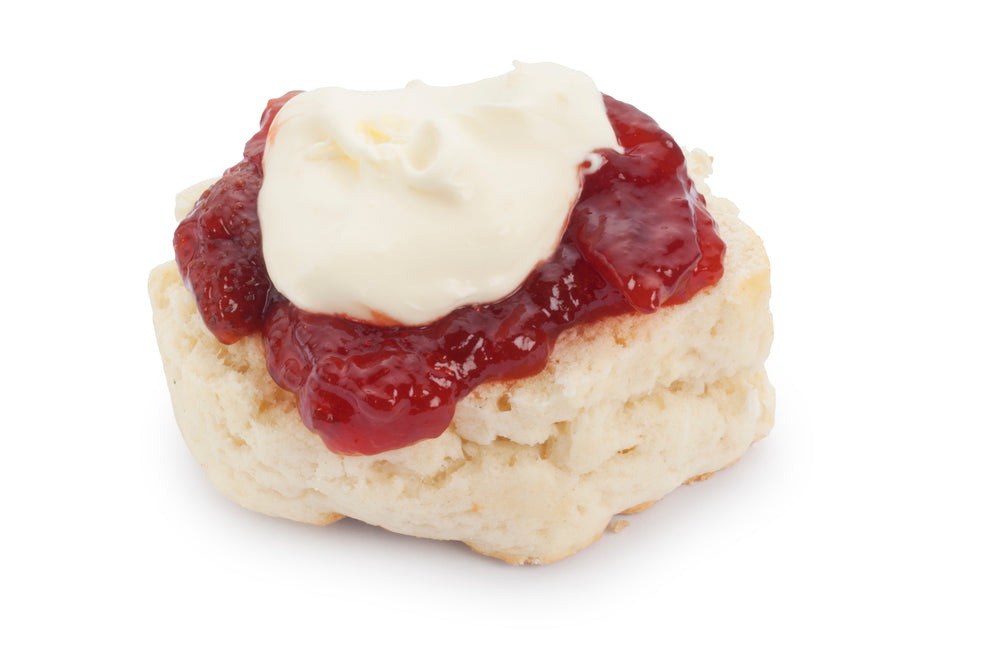In the UK, scones are a common accompaniment with afternoon tea, and they are frequently enjoyed with clotted cream and sometimes jam, too. It is their interesting texture that makes them so delicious and alluring. They aren't pastries or biscuits but are not cakes as well. Traditional scones with a large dollop of clotted cream make a delicious treat or snack for any time.
History of Scones and Clotted Cream
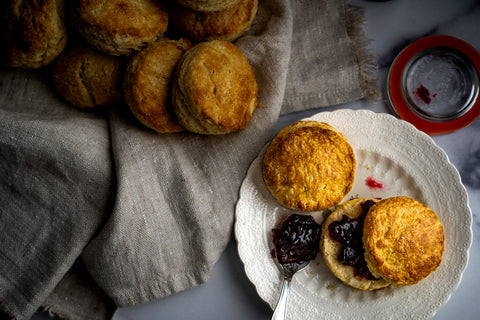
It is believed that the first Scones appeared in Scotland in the early 1500s; the earliest known scone was baked in 1513 by a Scottish poet.
Originally, a large circle of oats that had been cut into four or six wedges was used to make the first scones. Modern variations are made with flour and baked instead of roasted over an open flame.
Although traditional English scones may have raisins or currants, they are usually plain, and besides a clotted cream, people like to flavour them with jam, preserves, lemon curd, and honey. Popular gourmet scones without butter or jam include cranberries, dates, almonds, orange rind, chocolate morsels, and other ingredients.
The Dutch words 'schoonbrot', which means fine white bread, and 'sconbrot', which means fine or lovely bread, may have some bearing on the etymology of the word 'scones'.
History of Clotted Cream
Clotted Cream has been one of the favourite desserts of Southwest Britain. It has a long history that was borne out of necessity. Farmers initially made it to lessen milk waste. However, its origins are still somewhat of a mystery. Some speculate that Phoenician traders looking for tin may have brought it, while others believe that early Britons valued it for its ability to preserve freshness.
More recently, archaeologists have linked clotted cream to "fogous" and "linhays," stone buildings that may have served as ancient dairy cold storage. For years, there has been a heated argument about which county creates the best-clotted cream: Devon or Cornwall.
Some old records show that the monks of Tavistock Abbey made clotted cream in the 14th century and even gave it away as payment for aid with repairs. It became quite popular in the 19th century because people thought digesting clotted cream instead of raw cream was simpler. It was so widely utilized that Devon even used it to produce butter – the final product was extremely delicious, lasted longer, and was very flavourful.
Today, clotted cream is still quite famous in Southwest Britain. It is frequently sent as an extra-special treat to friends and family around the British Isles. It is a custom that honours this delectable dairy product that has been around for centuries.
How are Scones and Clotted Cream Savoured?
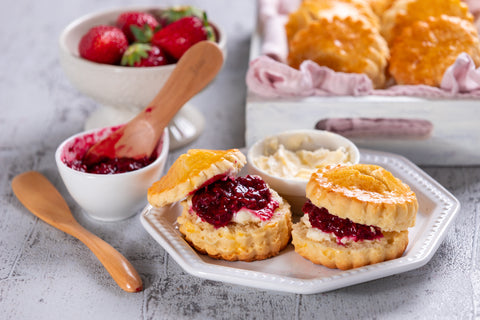
Many people disagree on the ‘proper’ way to eat a scone. Whether one bites right into it or takes the jam and cream first out to prevent more mess? Although Devon and Cornwall enjoy a good cream tea, they consume their scones differently. In Cornwall, clotted cream is typically poured on top of warm scones after the jam has been spread on top to allow the jam to soak in. In Devon, a layer of clotted cream is applied first before adding a layer of runny jam. A scone is considered incomplete without cream or jam. Together, they give the scones a delicious taste.
Recipe for Scones
Ingredients
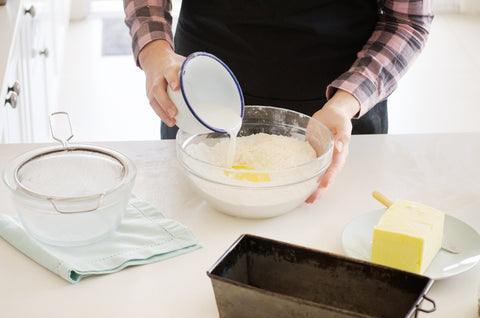
- 2 cups all-purpose flour
- ¼ cup granulated sugar
- 1/3 cup cold unsalted butter, diced
- 2/3 cup milk
- 1 tbsp baking powder
- ½ tsp salt
- 1 teaspoon vanilla extract – optional
- 1/2 cup raisins or currants - optional
- Some milk for brushing
- Jam and clotted cream for serving
Instructions:
- First, make your oven preheated to 425°F (220°C). Line a baking sheet with parchment paper.
- Take a large bowl, mix together flour, sugar, baking soda and salt.
- To the dry ingredients, add the chilled diced butter and mix till the flour mixture resembles coarse breadcrumbs.
- Add the milk and the vanilla extract. Mix just until the dough combines. Gently mix raisins or currants into the dough if you are using them.
- Spread the dough on a surface dusted with flour. It should be gently kneaded a few times to come together into a ball – you must be able to see some bits of butter. Do not over-knead.
- Roll out the dough to around 1-inch thickness. Scones should be cut using a circular biscuit cutter with a diameter of around 2 inches. To cut, press the cutter down without twisting it.
- The scones should be placed on the prepared baking sheet ensuring a few inches between each one. To help the tops brown, lightly brush them with milk.
- Once baked, place the scones on a wire rack and serve with clotted cream.
Recipe for Clotted Cream
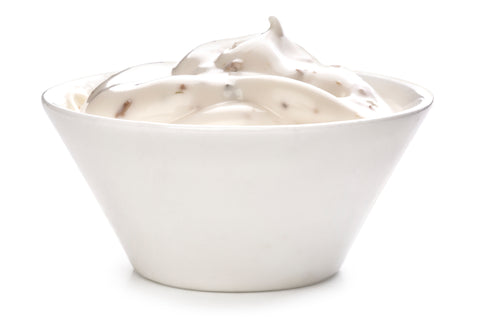
While there are many small countryside dairies and other brands that make good clotted cream. Many households prefer to make them at home, too. Here is a small guide that can be used to make clotted cream:
Ingredients
- 2 Cups of Heavy Cream
Equipment
- A large saucepan
- A wide and shallow ovenproof pan or dish
- A fine-mesh strainer
Instructions
- Preheat your oven to a low temperature of around 180°F (80°C).
- Make sure the layer of heavy cream is quite thin when you pour it into the large, shallow, ovenproof dish or pan.
- Place the dish in the oven and bake it slowly for a long time— between 8 and 12 hours. The cream will become thicker and form a crust that is somewhat browned on top.
- Remove the clotted cream from the oven once the top has developed a thick, golden shell and the interior has thickened. Give it time to reach room temperature.
- Place the dish in the refrigerator overnight or for at least six hours. The clotted cream will settle down during this chilling time.
- After cooling, the dish will have a thick coating of clotted cream on top. Use a fine-mesh sieve or muslin cloth to gently remove it, and let any extra liquid drain away.
- Store the clotted cream in an airtight dish and keep it in the fridge. It will last you for a week.
Enjoy your scones along with clotted cream – everything made at home!!


 Easter 2026
Easter 2026
 Frozen Food
Frozen Food
 Baking
Baking
 Beans, Peas, Soups & Tins
Beans, Peas, Soups & Tins
 Biscuits, Crackers & Cookies
Biscuits, Crackers & Cookies
 Candy / Sweets
Candy / Sweets
 Crisps & Snacks
Crisps & Snacks
 Chemist / Pharmacy
Chemist / Pharmacy
 Desserts
Desserts
 Gravy, Stock & Paste
Gravy, Stock & Paste
 Haggis
Haggis
 Indian Sauces, Paste and Pickle
Indian Sauces, Paste and Pickle
 Jams & Preserves
Jams & Preserves
 Poppy Appeal
Poppy Appeal
 Pot Noodles & Super Noodles
Pot Noodles & Super Noodles
 Scone Mix
Scone Mix
 Gluten-Free / Free From
Gluten-Free / Free From
 Tea Accessories
Tea Accessories
 Teapot & Tea sets
Teapot & Tea sets
 Tea For One
Tea For One
 Sugar & Creamer
Sugar & Creamer
 Tableware
Tableware
 Serveware
Serveware
 Plates & Trays
Plates & Trays
 Bowls
Bowls
 Cups & Saucers
Cups & Saucers
 Mugs
Mugs
 Silverware
Silverware
 Dinnerware - Accessories
Dinnerware - Accessories
 Dinnerware - For Pets
Dinnerware - For Pets
 Victoria Eggs - Hand-Drawn UK Homeware
Victoria Eggs - Hand-Drawn UK Homeware
 Jewelry & Accessories
Jewelry & Accessories
 Sale
Sale
 Christmas Gifts
Christmas Gifts
